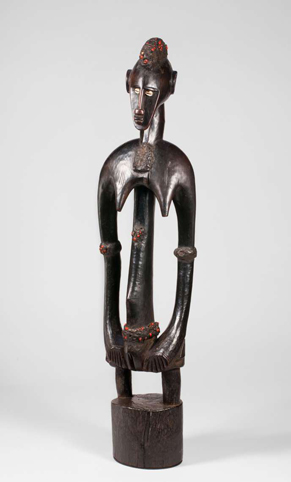wolfgang-jaenicke
A Senufo Rhythmpounder
A Senufo Rhythmpounder
Couldn't load pickup availability
A Senufo Rhythmpounder - called Deblé - Sikasso region.
A Senufo rhythm pounder, known as a Déblé, is a ceremonial sculpture used in the rituals of the Poro society among the Senufo people of West Africa, particularly in the Sikasso region of Mali. These figures are integral to various rites, including initiations, agricultural ceremonies, and funerals. During funerals, the Déblé is held by the elbows and rhythmically pounded on the earth, producing a dull sound that invites the souls of deceased ancestors to participate in the ceremonies and purifies the earth.
The Déblé sculptures are characterized by their stylized and abstract forms, often featuring elongated torsos, slender limbs, and distinctive facial features. The face typically displays minimalistic features, with incised lines representing eyes, nose, and mouth. The body may exhibit scarification patterns, and the figures often have elaborate coiffures or headgear. The sculptures are crafted from dense hardwoods and are polished to a lustrous patina, reflecting their ritual significance and the reverence with which they are treated.
In the Sikasso region, these sculptures are particularly noted for their unique stylistic elements. For instance, a notable piece from this region features a cylindrical base, short legs, an elongated torso with radial scarification marks around the navel, and a head with a flat nose and stylized facial features. The ears are designed as rings with deepening centers, adorned with cowrie shells, indicative of the region's distinctive artistic style.
The Déblé serves not only as a ritual object but also as a symbol of the Senufo people's connection to the spiritual world, embodying ancestral presence and cultural identity. Source: Chat GPT
Lit.: A lecture of Dr. Junker, "der Originalzustand.. Wo ist er geblieben?" Gottschalk Burkhard, "Senufo, Massa und die Statuen des poro" 2002: 43; Glaze Anita J., "Art and Death in a Senufo Village", Indiana University Press, Bloomington 1981. A related eyemplare: Robert Goldwater, Senufo Sculpture from West Africa, New York, 1964, ills. 88 and 88a, Werner Gillon, Collecting African Art, London, 1979, p. 50, fig. 38 William Rubin, "Primitivism" in 20th Century Art: Affinity of the Tribal and the Modern, New York, 1984, vol. 1, p. 131 William Rubin, Le Primitivisme dans l’art du 20e siècle. Les artistes modernes devant l’art tribal, Paris, 1987, p. 131 Jacques Kerchache, Jean-Louis Paudrat and Lucien Stéphan, L'art africain, Paris, 1988, p. 82, pl. 34, Jacques Kerchache, Jean-Louis Paudrat, and Lucien Stéphan (eds.), Die Kunst des Schwarzen Afrika, Freiburg, 1989, p. 80, pl. 34 Jacques Kerchache, Jean-Louis Paudrat and Lucien Stéphan, Art of Africa, New York, 1993, p. 82, pl. 34 Mary H. Nooter, Secrecy: African Art that Conceals and Reveals, New York, 1993, p. 155, cat. 79.
According to Gottschalk, who tried to make a typolgy of the Senufo Déblé, these exemplares would probably be submitted to the group of the kulibèlè and not the fonombèlè.
"While the former (fonombèlè), either because of a lack of ability for finer work (the fonombèlè are the blacksmiths in the Senufo society) or as a consciously used stylistic device, left the clear and powerful forms, the contrasting horizontals and verticals, largely as they were when they were defined of the proportions, the kulibèlè (the traditional carvers) tried to ensure that the body parts flowed smoothly into one another, as long as they did not incorporate the style of their older brothers into their work or more or less copy it." Source: Burkhard Gottschalk.
More realistic sounds the opinion of Glaze, who described the difficulties of a stylistic typology according to both ethnic groups after she did fieldwork around kufulo (region of Dikodougou). Anita J. Glaze, 81.
Museums: Brooklyn Museum, Yale University Art Gallery
Auctionhouses: Christies, Sothebys, Dorotheum, Lempertz
Private Galleries: Rand African Art, Wolfgang Jaenicke
wj
Height: 93 cm
Weight: 8,1 kg

A Rhythmpounder from the same region, also collected in the Nafou region, which we sold three years ago.

Source: Susan Elisabeth Gagliardi,Cleveland Museum, Ohio, USA. Senufo Unbound, pate 46/47 (mostly wellknown is the "Western Provenance" ,in the description we read "unknown artist".Perhaps one could say that this is a postcolonial, Western view of Africa, because the makers of these sculptures do not see themselves as "artists" in Africa. They are craftsmen, often blacksmiths, who, despite being integrated into village communities, usually live on the outskirts of the villages. Learning where these villages are and how the carvers influenced each other might say more about Africa than a "family tree" of Western owners. But that would mean that anthropologists do field research in Africa instead of running museums that are under the influence of the art trade.




































